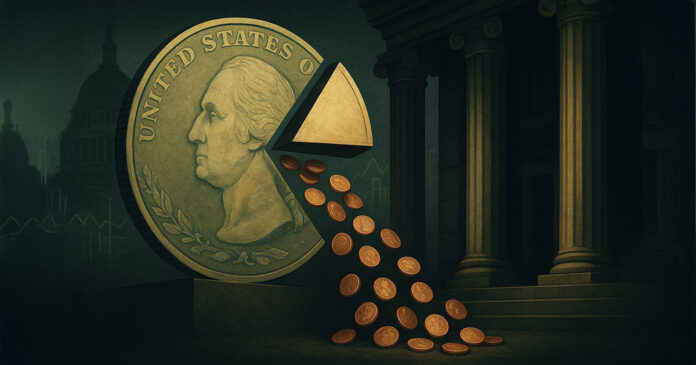US Debt Reaches Unprecedented Levels: A Fiscal Abyss
The United States is facing a historical reality, with its entire debt exceeding $37.43 trillion in September 2025. This staggering figure has led to a significant increase in interest payments, consuming almost a quarter of every tax dollar collected. The nation’s debt load has been steadily rising, with an increase of $2.09 trillion in the past year alone.
The Relentless Rise of US Debt
According to recent updates from the US Ministry of Finance and the Joint Economic Committee, the public debt has reached $37.43 trillion. This has resulted in interest payments of $478 billion for the 2025 financial year, a 17% increase compared to the previous year. The interest payments now account for approximately 23 cents of every dollar collected by the IRS, a proportion that has risen sharply due to the normalization of global interest rates after years of quantitative easing.
Tariffs: Large Numbers, Small Effects
In recent years, the US government has received record tariff income, particularly after the introduction of new import duties during the Trump administration. However, despite these increased revenues, the national debt continues to grow, with rising interest costs exceeding the increase in tariff revenues. The IMF has warned that the impact of tariff revenues is “very uncertain,” while Eliant Capital noted that “despite the tariff revenues, the deficit for July was $291 billion, with the US collecting $630 billion and spending $338 billion, meaning that 46 cents was borrowed for every dollar spent.”
Nothing Stops This Train
Macro analyst Lyn Alden has popularized the thesis “Nothing Stops This Train,” arguing that persistent deficits and relentless spending have led to an era of fiscal dominance, making material budget reform politically impossible. Alden believes that the relentless provision of debt is structurally ingrained in the system and that only a paradigm shift, such as a move to hard money, can break the cycle. According to the Peterson Foundation, interest payments are now the third largest outlay category for the federal government, exceeding almost every other program except for social security and Medicare.
Alternatives to Fiat Currency
As interest payments consume increasingly larger shares of federal revenue, traditional remedies such as tariffs and spending cuts are being reevaluated. The conversation is shifting towards “hard money” solutions, such as Bitcoin and gold, which are being considered as alternatives to fiat currency in a time of persistent monetary expansion. Both gold and Bitcoin have seen strong demand as stores of value, with gold reaching an all-time high of over $3,600 per ounce in mid-September 2025, representing a 41% increase over the previous year.
Investors Seek Refuge in Alternative Assets
Bitcoin, often referred to as “digital gold,” has seen a significant price increase, nearing $108,000, after a brief downturn in September. Many analysts, including Lyn Alden, expect the price to reach at least $150,000 by the end of the current cycle. As the US debt continues to spiral out of control, alternative assets like Bitcoin and gold are being considered essential components of diversified portfolios, offering a hedge against inflation and fiscal uncertainty. For more information, visit https://cryptoslate.com/23-cents-of-every-tax-dollar-goes-to-pay-interest-on-u-s-debt/

